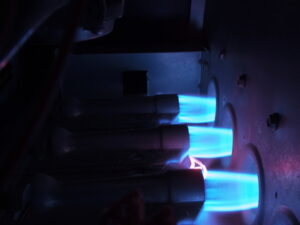 Gas furnaces are the heating systems most commonly found in homes. They’re powerful and energy efficient—and they’re also relatively safe to run. Homeowners are sometimes nervous about using natural gas because any gas appliance can potentially create hazards from combustion and the exhaust of toxic gases like carbon monoxide. A gas furnace can become hazardous if its routine maintenance is neglected or if it doesn’t receive prompt repairs as necessary. But if you take good care of your home’s gas furnace, you shouldn’t need to worry about it becoming dangerous.
Gas furnaces are the heating systems most commonly found in homes. They’re powerful and energy efficient—and they’re also relatively safe to run. Homeowners are sometimes nervous about using natural gas because any gas appliance can potentially create hazards from combustion and the exhaust of toxic gases like carbon monoxide. A gas furnace can become hazardous if its routine maintenance is neglected or if it doesn’t receive prompt repairs as necessary. But if you take good care of your home’s gas furnace, you shouldn’t need to worry about it becoming dangerous.
The reason we can say this is because modern gas furnaces have special safety features designed into them. To help you understand how your own furnace keeps you and your family safe, we’re going to look at some of these safety components.
If you ever have concerns about the safe operation of your furnace, call us for furnace repair in Katy, TX. We’ll make sure you can enjoy your furnace in peace.
The flame rollout sensor
A furnace is essentially a fire burning in part of your house that’s used to heat the air send into the ductwork. The fire comes from gas burners and remains inside the fire box. However, it’s possible for a flame “rollout” to occur. This is when the burners have insufficient oxygen, causing the flames to move to wherever they can find it—which often means the flames will leap outside of the furnace! The rollout sensor detects when flames attempt to leave the fire box and immediately shuts off the gas to burners.
The flame sensor
When gas flows to the burners, a pilot light or electronic ignitor lights them. If they fail to light, it creates the danger of unburned gas flooding the combustion chamber and creating an explosion. To prevent this, a flame sensor will shut off gas flow if it doesn’t detect that the burners have lit.
The high heat limit switch
A significant safety concern with any furnace is that it will overheat. This occurs when the heat exchanger—the metal container that holds the hot combustion gas—fails to cool down. The high heat limit switch is located just past the exchanger and registers the temperature of the air coming from the exchanger. If the air’s temperature is too high, the limit switch shuts off the gas to the furnace. During normal operating, the limit switch’s job is to turn the blower fan on and off.
The flue exhaust pressure sensor
The danger of toxic gases in a furnace mostly comes from the exhaust gases in the heat exchanger. After most of the gas has been combusted, the remaining byproducts contain toxic carbon monoxide. To prevent this from getting inside the living space of a home, an inducer motor activates to draw the gases from the heat exchanger and up through a flue where the gases safely exit through the roof. If the flue becomes blocked, it can push these gases back down into the furnace and the house. To stop this from occurring, the flue exhaust pressure sensor detects the increase in pressure from the blockage and shuts off the furnace. The furnace won’t be able to run again until the blockage is removed.
At AC Comfort, Your Comfort Is Our Business! Call us whenever you need heating service.

